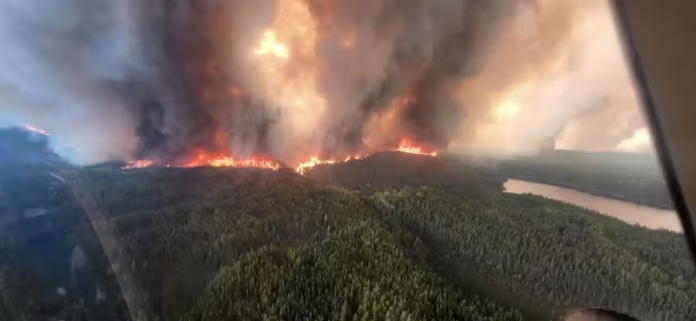Canada (KAAB TV) – Canada is grappling with one of its most intense wildfire seasons in recent memory, as multiple provinces declare states of emergency and thousands of residents are forced to evacuate.
Manitoba Declares State of Emergency
The province of Manitoba has declared a state of emergency due to extensive wildfires, prompting the evacuation of 17,000 residents from multiple communities.
Premier Wab Kinew described the scale of the evacuation as unprecedented in recent memory.
In response, Prime Minister Mark Carney has deployed military assistance to facilitate large-scale evacuations and provide shelter.
The city of Flin Flon, with 5,000 residents, issued a mandatory evacuation as wildfires approached, directing residents to leave by midnight using the only available route, Highway 10, leading toward Winnipeg.
The blaze began in neighboring Saskatchewan and quickly expanded, also leading to the evacuation of Creighton. Currently, Manitoba is battling 22 active wildfires, with support from national firefighting teams.
This year, the province has already experienced 102 wildfires, surpassing the seasonal average of 77.
Alberta’s Oil Operations Disrupted
In Alberta, a large wildfire has forced the temporary shutdown of oil and gas operations and triggered evacuations in the town of Swan Hills.
The fire, which spans approximately 1,600 hectares, is burning out of control about 7 kilometers north of the town.
As a safety precaution, Aspenleaf Energy halted production of around 4,000 barrels of oil equivalent per day and evacuated its field staff.
Roughly 1,200 residents of Swan Hills were evacuated to a reception center in Whitecourt. Another out-of-control wildfire, about 390 hectares in size, is active in Yellowhead County.
These are Alberta’s first significant wildfires of the spring, following a devastating fire season last year.
British Columbia Faces Early Wildfire Threat
Canada’s 2025 wildfire season commenced with significant activity in British Columbia, where officials reported 26 active wildfires, two of which were out of control.
Unseasonably warm, dry, and windy weather conditions have elevated the fire risk throughout the province.
One fire, covering 56 hectares, is located north of Fort St. John and caused temporary evacuations; however, residents were allowed to return as the fire moved away from the city.
The second major wildfire, spanning 185 hectares, is burning southeast of Dawson Creek. Provincial authorities are urging residents to avoid any open burning and to report all wildfires promptly.
Federal Government’s Response
The federal government has announced significant investments to bolster wildfire response and preparedness.
In January, Canada and Quebec announced a joint investment of $64 million over three years through the Fighting and Managing Wildfires in a Changing Climate Program (FMWCC) – Equipment Fund.
This funding supports Quebec’s efforts to purchase wildfire firefighting equipment, such as vehicles, drones, and telecommunications equipment.
In February, Canada and New Brunswick announced a joint investment of $40.1 million over four years to support wildfire preparation through the application of FireSmart practices in New Brunswick.
These investments aim to help prevent wildfires and mitigate their impacts at the community level.
Outlook
As Canada faces an unprecedented wildfire season, authorities continue to battle active fires and coordinate evacuations.
The federal and provincial governments are working together to strengthen wildfire response capabilities and enhance community resilience.
Residents are urged to stay informed, follow evacuation orders, and take necessary precautions to protect themselves and their families.


